《儿科学》课程教学资源(授课教案)11 Acute Convulsion in Children
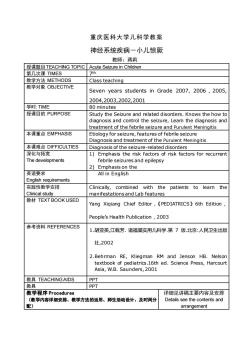
重庆医科大学儿科学教案神经系统疾病一小儿惊厥教师:蒋莉授课题目TEACHINGTOPICAcute Seizure in Children第几次课TIMES7th教学方法METHODSClass teaching教学对象OBJECTIVESeven years students in Grade 2007,2006,2005,2004,2003,2002,2001学时:TIME80minutes授课目的PURPOSEStudy the Seizure and related disorders. Knows the how todiagnosis and control the seizure, Leam the diagnosis andtreatmentofthefebrileseizureandPurulentMeningit本课重点EMPHASISEtiology for seizure, features of febrile seizureDiagnosis and treatment of the Purulent Meningitis本课难点 DIFFICULTIESDiagnosis of the seizure-related disorders深化与拓宽1)Emphasistheriskfactors of riskfactorsforrecurrentThe developmentsfebrile seizures and epilepsy2) Emphasis on the英语要求All inEnglishEnglishrequirements实践性教学安排Clinically, combined with the patients to learn theClinical studymanifestations and Lab features教材TEXTBOOKUSEDYang Xiqiang Chief Editor,《PEDIATRICS》 6th EditionPeople's Health Publication,2003参考资料REFERENCES1.胡亚美,江载芳.诸福棠实用儿科学.第7版.北京:人民卫生出版社,20022.BehrrmanRE,KliegrRMandJHB.Nelsortextbook of pediatrics.16th ed. Science Press, HarcourtAsia, W.B. Saunders,2001教具TEACHINGAIDSPPT教具PPT教学程序Procedures详细见讲稿主要内容及安排(教学内容详细安排、教学方法的运用、师生活动设计、及时间分Details see the contents and配)arrangement
重庆医科大学儿科学教案 神经系统疾病-小儿惊厥 教师:蒋莉 授课题目TEACHING TOPIC Acute Seizure in Children 第几次课 TIMES 7th 教学方法 METHODS Class teaching 教学对象 OBJECTIVE Seven years students in Grade 2007, 2006,2005, 2004,2003,2002,2001 学时: TIME 80 minutes 授课目的 PURPOSE Study the Seizure and related disorders. Knows the how to diagnosis and control the seizure, Learn the diagnosis and treatment of the febrile seizure and Purulent Meningitis 本课重点 EMPHASIS Etiology for seizure, features of febrile seizure Diagnosis and treatment of the Purulent Meningitis 本课难点 DIFFICULTIES Diagnosis of the seizure-related disorders 深化与拓宽 The developments 1) Emphasis the risk factors of risk factors for recurrent febrile seizures and epilepsy 2) Emphasis on the 英语要求 English requirements All in English 实践性教学安排 Clinical study Clinically, combined with the patients to learn the manifestations and Lab features 教材 TEXT BOOK USED Yang Xiqiang Chief Editor,《PEDIATRICS》6th Edition , People’s Health Publication,2003 参考资料 REFERENCES 1.胡亚美,江载芳. 诸福棠实用儿科学.第 7 版.北京:人民卫生出版 社,2002 2.Behrman RE, Kliegman RM and Jenson HB. Nelson textbook of pediatrics.16th ed. Science Press, Harcourt Asia, W.B. Saunders, 2001 教具 TEACHING AIDS PPT 教具 PPT 教学程序 Procedures (教学内容详细安排、教学方法的运用、师生活动设计、及时间分 配) 详细见讲稿主要内容及安排 Details see the contents and arrangement
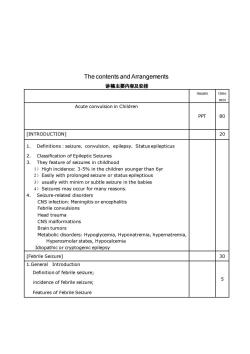
The contents and Arrangements讲稿主要内容及安排timemeansminAcute convulsion in ChildrenPPT8%20[INTRODUCTION]Definitions:seizure、convulsion、epilepsy、Status epilepticus1.2.Classification of Epileptic SeizuresThey feature of seizures in childhood3.1) High incidence: 3-5% in the children younger than 6yr2) Easilywithprolongedseizureorstatusepileptious3) usually with minim or subtle seizure in the babies4) Seizures may occur for many reasons.Seizure-related disorders4.CNS infection: Meningitis or encephalitisFebrile convulsionsHead trauma CNS malformationsBrain tumorsMetabolic disorders: Hypoglycemia, Hyponatremia, hypernatremia,Hyperosmolar states, HypocalcemiaIdiopathic or cryptogenic epilepsy[Febrile Seizure]301.General IntroductionDefinition of febrile seizure;5incidence of febrile seizure;Features of Febrile Seizure
The contents and Arrangements 讲稿主要内容及安排 means time min Acute convulsion in Children PPT 80 [INTRODUCTION] 20 1. Definitions:seizure、convulsion、epilepsy、Status epilepticus 2. Classification of Epileptic Seizures 3. They feature of seizures in childhood 1) High incidence: 3-5% in the children younger than 6yr 2) Easily with prolonged seizure or status epileptious 3) usually with minim or subtle seizure in the babies 4) Seizures may occur for many reasons. 4. Seizure-related disorders CNS infection: Meningitis or encephalitis Febrile convulsions Head trauma CNS malformations Brain tumors Metabolic disorders: Hypoglycemia, Hyponatremia, hypernatremia, Hyperosmolar states, Hypocalcemia Idiopathic or cryptogenic epilepsy [Febrile Seizure] 30 1.General Introduction Definition of febrile seizure; incidence of febrile seizure; Features of Febrile Seizure 5
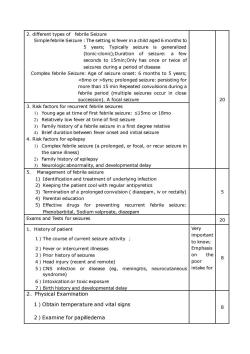
2.different types of febrile SeizureSimplefebrile Seizure : The setting is fever in a child aged 6 moinths5 years; Typically seizure is generalized(tonic-clonic);Duration of seizure: a fewseconds to 15min;Only has once or twice of seizures during a period of diseaseebrile Seizure: Age of seizure onset: 6 months to 5 yeaComple6yrs; prolonged seizure: persisting formore than 15 min Repeated convulsions during afebrile period (multiple seizures occur in closesuccession). A focal seizure203.Risknt febrile seizuresecurr1) Young age at time of first febrile seizure: ≤15mo or 18mo2) Relatively low fever at time of first seizure3)Family history ofa febrle seizure inafirst degree relative4) Brief duration between fever onset and initial seizure4.Riskfactorsforepilepsy1) Complex febrile seizure (a prolonged, or focal, or recur seizure inthe same illness)2) Family history of epilepsy3) Neurologic abnormality, and developmental delayManagement of febrileseizure1) Identification and treatment of underlying infection2) Keeping the patient cool with regular antipyretics3) Termination of a prolonged convulsion ( diazepam, iv or rectally)54)Parental educatior5)Effectivedrugsforpreventing recurrent febrile seizure:Phenobarbital, Sodium valproate, diazepamExams and Tests for seizures20Very1、History of patientimportant1)Thecourseof currentseizureactivitytoknow;2) Fever or intercurrent illnessesEmphasisonthe3)Priorhistoryof seizurespoor4) Head injury (recent and remote)intake for5)CNS infectionor disease (eg, meningitis,arnesyndrome)6) Intoxicationor toxic exposure)Birthhistoryanddevelopmentaldelay2、PhysicalExamination1) Obtain temperature and vital signs2)Examineforpapilledema
2. different types of febrile Seizure Simple febrile Seizure : The setting is fever in a child aged 6 months to 5 years; Typically seizure is generalized (tonic-clonic);Duration of seizure: a few seconds to 15min;Only has once or twice of seizures during a period of disease Complex febrile Seizure: Age of seizure onset: 6 months to 5 years; 6yrs; prolonged seizure: persisting for more than 15 min Repeated convulsions during a febrile period (multiple seizures occur in close succession). A focal seizure 20 3. Risk factors for recurrent febrile seizures 1) Young age at time of first febrile seizure: ≤15mo or 18mo 2) Relatively low fever at time of first seizure 3) Family history of a febrile seizure in a first degree relative 4) Brief duration between fever onset and initial seizure 4. Risk factors for epilepsy 1) Complex febrile seizure (a prolonged, or focal, or recur seizure in the same illness) 2) Family history of epilepsy 3) Neurologic abnormality, and developmental delay 5. Management of febrile seizure 1) Identification and treatment of underlying infection 2) Keeping the patient cool with regular antipyretics 3) Termination of a prolonged convulsion ( diazepam, iv or rectally) 4) Parental education 5) Effective drugs for preventing recurrent febrile seizure: Phenobarbital, Sodium valproate, diazepam 5 Exams and Tests for seizures 20 1、History of patient 1)The course of current seizure activity ; 2)Fever or intercurrent illnesses 3)Prior history of seizures 4)Head injury (recent and remote) 5)CNS infection or disease (eg, meningitis, neurocutaneous syndrome) 6)Intoxication or toxic exposure 7)Birth history and developmental delay Very important to know; Emphasis on the poor intake for 8 2、Physical Examination 1)Obtain temperature and vital signs 2)Examine for papilledema 8
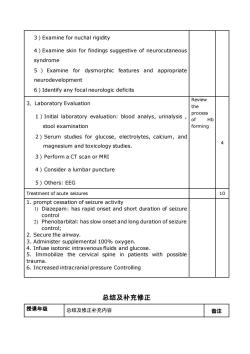
3) Examine for nuchal rigidity4) Examine skin for findings suggestive of neurocutaneoussyndrome5 ) Examine for dysmorphic features and appropriateneurodevelopment6) Identify any focal neurologic deficitsReview3、Laboratory Evaluationtheprocess1) Initial laboratory evaluation: blood analys, urinalysis,ofHbstool examinationforming 2) Serum studies for glucose, electrolytes, calcium, andmagnesium and toxicology studies3) Perform a CT scan or MRI4) Consider a lumbar puncture5) Others: EEG10Treatment of acute seizures1.promptcessation of seizure activity1) Diazepam: has rapid onset and short duration of seizurecontrol2) Phenobarbital: has slow onset and long duration of seizurecontrol;2.Securethe airway.3. Administer supplemental 100% oxygen.4. Infuse isotonic intravenous fluids and glucose.5.Immobilize the cervical spine in patients with possibletrauma.6. Increased intracranial pressure Controlling总结及补充修正授课年级总结及修正补充内容备注
3)Examine for nuchal rigidity 4)Examine skin for findings suggestive of neurocutaneous syndrome 5 ) Examine for dysmorphic features and appropriate neurodevelopment 6)Identify any focal neurologic deficits 3、Laboratory Evaluation 1)Initial laboratory evaluation: blood analys, urinalysis , stool examination 2)Serum studies for glucose, electrolytes, calcium, and magnesium and toxicology studies. 3)Perform a CT scan or MRI 4)Consider a lumbar puncture 5)Others: EEG Review the process of Hb forming 4 Treatment of acute seizures 10 1. prompt cessation of seizure activity 1) Diazepam: has rapid onset and short duration of seizure control 2) Phenobarbital: has slow onset and long duration of seizure control; 2. Secure the airway. 3. Administer supplemental 100% oxygen. 4. Infuse isotonic intravenous fluids and glucose. 5. Immobilize the cervical spine in patients with possible trauma. 6. Increased intracranial pressure Controlling 总结及补充修正 授课年级 总结及修正补充内容 备注
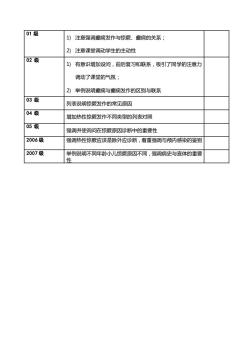
01级1)注意强调癫痫发作与惊厥、癫痫的关系;2)注意课堂调动学生的主动性02级1)有意识增加设问,前后复习和联系,吸引了同学的注意力调动了课堂的气氛;2)举例说明癫痫与癫痫发作的区别与联系03级列表说明惊蕨发作的常见原因04级增加热性惊厥发作不同类型的列表对照05级强调并使询问在惊厥原因诊断中的重要性2006级强调热性惊厥应该是除外应诊断,着重强调与颅内感染的鉴别2007级举例说明不同年龄小儿惊厥原因不同,强调病史与查体的重要性
01 级 1) 注意强调癫痫发作与惊厥、癫痫的关系; 2) 注意课堂调动学生的主动性 02 级 1) 有意识增加设问,前后复习和联系,吸引了同学的注意力 调动了课堂的气氛; 2) 举例说明癫痫与癫痫发作的区别与联系 03 级 列表说明惊厥发作的常见原因 04 级 增加热性惊厥发作不同类型的列表对照 05 级 强调并使询问在惊厥原因诊断中的重要性 2006 级 强调热性惊厥应该是除外应诊断,着重强调与颅内感染的鉴别 2007 级 举例说明不同年龄小儿惊厥原因不同,强调病史与查体的重要 性
按次数下载不扣除下载券;
注册用户24小时内重复下载只扣除一次;
顺序:VIP每日次数-->可用次数-->下载券;
- 《儿科学》课程教学资源(授课教案)13 Immunodeficiency.doc
- 《儿科学》课程教学资源(授课教案)10 Nutritional Iron Deficiency Anemia.doc
- 《儿科学》课程教学资源(授课教案)15 Growth Hormone Deficiency.doc
- 《儿科学》课程教学资源(授课教案)14 Congenital Hypothyroidism.doc
- 《儿科学》课程教学资源(授课教案)17 Varicella.doc
- 《儿科学》课程教学资源(授课教案)16 Measles.doc
- 《儿科学》课程教学资源(授课教案)19 Tuberculosis Meningitis.doc
- 《儿科学》课程教学资源(授课教案)20 Toxic Bacillary Dysentery.doc
- 《儿科学》课程教学资源(授课教案)21 Chronic Gastritis in Children.doc
- 《儿科学》课程教学资源(授课教案)18 Primary Pulmonary Tuberculosis.doc
- 《儿科学》课程教学资源(授课教案)24 Mumps.doc
- 《儿科学》课程教学资源(授课教案)22 Infantale Diarrhea and Fluid Therapy.doc
- 《儿科学》课程教学资源(授课教案)23 Infantile Hepatitis Syndrome.doc
- 《儿科学》课程教学资源(授课教案)25 Scarlet Fever.doc
- 《儿科学》课程教学资源(授课教案)01 Introduction of Pediatrics.doc
- 《儿科学》课程教学资源(授课教案)04 Neonatal Jaundice.doc
- 《儿科学》课程教学资源(授课教案)05 Neonatal Septicemia.doc
- 《儿科学》课程教学资源(授课教案)02 Growth and Development.doc
- 《儿科学》课程教学资源(授课教案)03 Nutrition During Childhood.doc
- 《儿科学》课程教学资源(授课教案)09 Haematopoiesis and Blood Cell Counts.doc
- 《儿科学》课程教学资源(授课教案)12 Acute Glomerulonephritis,Nephrotic Syndrome.doc
- 《儿科学》课程作业习题(复习题)08 questions of immune system.doc
- 《儿科学》课程作业习题(复习题)07 questions of urinological system.doc
- 《儿科学》课程作业习题(复习题)09 questions of endocrine disorders.doc
- 《儿科学》课程作业习题(复习题)10 questions of infectious diseases.doc
- 《儿科学》课程作业习题(复习题)06 questions of nervous system.doc
- 《儿科学》课程作业习题(复习题)03 questions of respiratory diseases.doc
- 《儿科学》课程作业习题(复习题)04 questions of circulatory system.doc
- 《儿科学》课程作业习题(复习题)05 questions of blood disorders.doc
- 《儿科学》课程作业习题(复习题)02 questions of neonatal diseases.doc
- 《儿科学》课程作业习题(复习题)01 questions of children healthcare.doc
- 《儿科学》课程作业习题(典型病例)06 nephrotic syndrome-2.doc
- 《儿科学》课程作业习题(典型病例)06 anute nepheritis-1.doc
- 《儿科学》课程作业习题(典型病例)08 diarrhea.doc
- 《儿科学》课程作业习题(典型病例)03 congenital heart disease-VSD.doc
- 《儿科学》课程作业习题(典型病例)04 iron deficiency anemia.doc
- 《儿科学》课程作业习题(典型病例)05 purulent meningitis.doc
- 《儿科学》课程作业习题(典型病例)07 congenital hypothyroidism.doc
- 《儿科学》课程作业习题(典型病例)03 congenital heart disease-TOF.doc
- 《儿科学》课程作业习题(典型病例)01 ABO incompatibility of neonates.doc
